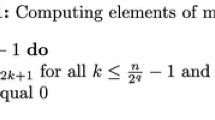We analyze certain chemical reaction networks and show that every solution converges to some steady state. The reaction kinetics are assumed to be monotone but otherwise arbitrary. When diffusion effects are taken into account, the conclusions remain unchanged. The main tools used in our analysis come from the theory of monotone dynamical systems. We review some of the features of this theory and provide a self-contained proof of a particular attractivity result which is used in proving our main result.
Similar content being viewed by others
References
Amann H. (1978). J. Math. Anal. Appl. 65: 432–467
Angeli D., Sontag E.D. (2003). IEEE Trans. Autom. Control 48: 1684–1698
Angeli D., Sontag E.D. (2004). Systems and Control Lett. 51: 185–202
Angeli D., De Leenheer P., Sontag E.D. (2004). Systems and Control Lett. 52: 407–414
D. Angeli and E.D. Sontag, Interconnections of monotone systems with steady-state characteristics, in Optimal Control, Stabilization, and Nonsmooth Analysis, eds. M. de Queiroz, M. Malisoff, and P. Wolenski (Springer-Verlag, Heidelberg, (2004) pp. 135–154).
Angeli D., Ferrell J.E., Jr., Sontag E.D. (2004). Proc. Natl. Acad. Sci. USA 101: 1822–1827
Chaves M., Sontag E.D. (2002). Eur. J. Control 8: 343–359
De Leenheer P., Angeli D., Sontag E.D. (2005). Math Biosci Eng. 2: 25–42
P. De Leenheer, D. Angeli an d E.D. Sontag, Crowding effects promote coexistence in the chemostat, submitted (also DIMACS Tech report 2003-44; preliminary version entitled ‘A feedback perspective for chemostat models with crowding effects’ has appeared in the Lecture Notes in Control and Inform. Sci., 294, 167–174 (2003)).
P. De Leenheer, S.A. Levin, E.D. Sontag and C.A. Klausmeier, Global stability in a chemostat with multiple nutrients, Accepted for publication in J. Math Biol. (also DIMACS Tech report 2003-40).
Feinberg M. (1987). Chem. Eng. Sci. 42: 2229–2268
Hirsch M.W. (1982). SIAM J. Appl. Math. 13: 167–179
Hirsch M.W. (1985). SIAM J. Math. Anal. 16: 423–439
Hirsch M.W. (1988). Nonlinearity 1: 51–71
Hirsch M.W. (1990). SIAM J. Math. Anal. 21: 1225–1234
Hirsch M.W. (1989). J. Diff. Eqns. 80: 94–106
Hirsch M.W., Smith H.L. (2003). Competitive and cooperative systems: a mini-review. Lecture Notes in Control and Inform. Sci. 294: 183–190
M.W. Hirsch and H.L. Smith, Generic quasi-convergence for strongly order preserving semiflows: a new approach, preprint.
Horn F.J.M., Jackson R. (1972). Arch. Ration. Mech. Anal. 49: 81–116
Jiang J.F. (1994). Bull. London Math. Soc. 26: 455–458
Kunze H., Siegel D. (2002). J Math Chem. 31: 339–344
Mierczynski J. (1987). SIAM J. Math. Anal. 18: 642–646
Mincheva M., Siegel D. (2004). Nonlinear Anal. 56: 1105–1131
A.J. Shapiro, The statics and dynamics of multicell reaction systems, Ph.D. Thesis, The University of Rochester, 1975, 176 pp (http://wwwlib.umi.com/dissertations/fullcit/7614785).
Siljak D.D. (1978). Large-scale Dynamic Systems. Elsevier, North-Holland
Smillie J. (1984). SIAM J. Math. Anal. 15: 530–534
H.L. Smith, Monotone Dynamical Systems (AMS, Providence (1995).
Smith H.L., Waltman P. (1995). The Theory of the Chemostat. Cambridge University Press, Cambridge
E.D. Sontag, Structure and stability of certain chemical networks and applications to the kinetic proofreading model of T-cell receptor signal transduction, IEEE Trans. Automat. Control 46 (2001) 1028–1047. Errata in IEEE Trans. Automat. Control 47 (2002) 705.
A.I. Volpert, V.A. Volpert and V.A. Volpert, Traveling wave solutions of parabolic systems (AMS, Providence, 1994).
Walcher S. (2001). J. Math. Anal. Appl. 263: 543–554
Author information
Authors and Affiliations
Corresponding author
Rights and permissions
About this article
Cite this article
Leenheer, P.D., Angeli, D. & Sontag, E.D. Monotone Chemical Reaction Networks. J Math Chem 41, 295–314 (2007). https://doi.org/10.1007/s10910-006-9075-z
Received:
Revised:
Published:
Issue Date:
DOI: https://doi.org/10.1007/s10910-006-9075-z




